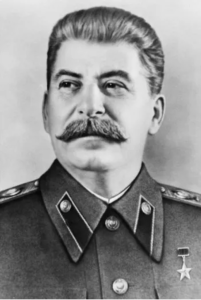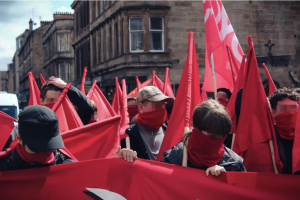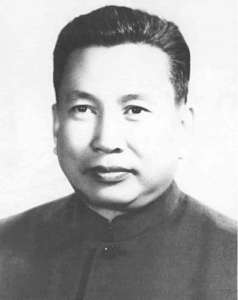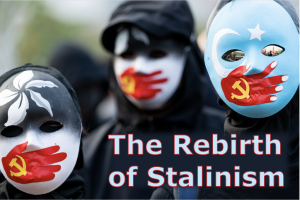The following article by Colm Breathnach was first posted by the Irish Independent Left. It draws our attention to the strange revival of Stalinism and how it can act as a conduit to the Hard Right.
THE STRANGE REBIRTH OF STALINISM
If you were suddenly transported from the aftermath of the fall of ‘communism’ in the early 1990s to 2023, you would be in for a rude shock. Going from a situation where even old-style communist parties accepted that the undemocratic nature of the USSR and its satellites was problematic, you would find hordes of net-warriors quoting Stalin’s works approvingly, defending the worst excesses of the Chinese klepto-capitalist regime and lauding Putin’s lumbering war machine as it slouches across Ukraine, raping, murdering and pillaging as it goes. How has it come to pass that there is nothing too reactionary, too anti-working class, too anti-human, for such so-called ‘leftists’ to justify? The answer is largely to be found in the bizarre re-emergence of a version of Stalinism amongst western leftists.

WHAT IS STALINISM?
Traditional Stalinism can be conceived of as a theoretical position, a state ideology and an imaginary. In terms of theory, it posits that socialism is achieved through the agency of a vanguard party, which, on achieving state power through revolution, uses the instrument of a one-party state to build a socialist, and eventually communist society. This is sometimes varied by a belief in ‘stages theory’ whereby, based on the social/political structure existent in a particular territory, it may be necessary to pass through certain stages, usually involving alliances with bourgeois democratic or nationalist forces before there can be a transition to socialism.
Secondly Stalinism is the ideology of the ruling class in a certain type of authoritarian socio-economic system, be it state capitalism, bureaucratic collectivism, klepto-capitalism, or a mixture of these. In this type of system, the ruling class, be they state bureaucrats, a patrimonial clique or state-adjacent capitalists, cannot maintain their rule purely by monopolisation of violence, so they need to achieve ideological hegemony. In the past the ruling class in ‘socialist’ states wielded some form of Stalinism (termed Marxism-Leninism) to justify and perpetuate their rule. This was often mixed with a strong dose of nationalism, sometimes drifting towards racism, often aimed at national minorities (see the treatment of the Turkish speaking minority in ‘socialist’ Bulgaria etc.). Ideological rhetoric was used to justify their exploitation of the workers and peasants, while also providing a link with left-wing movements world-wide. With the collapse of the ‘socialist states’ in Eastern Europe the role of Stalinism-nationalism as a state ideology is now largely confined to East Asia–China, Vietnam, North Korea and Laos.
But Stalinism is also a contemporary imaginary: a belief in the past existence of ‘socialism’ in the USSR that provides positive lessons for today. For some, China is the more successful version of a supposedly socialist state, a version that has managed to avoid collapse by incorporating and subordinating capitalism, a state-system that is superior to bourgeois democracy. Whether by reference to the Soviet past or to twenty-first century China, some leftists still console themselves by believing in the existence of a socialist reality.
WHAT’S THE PROBLEM WITH THE REBIRTH OF STALINISM?
Some on the left acknowledge the revival of Stalinism but minimise the seriousness of it. Why, they ask, get worked up about what is largely the domain of fringe groups? Surely, we have much more serious issues to contend with. This response is fundamentally flawed.
The fundamental meaning of socialism, not ideological nit-picking, is at stake. Either socialism means a free society based on workers control of all aspects of their lives or it means authoritarian one-party state ruled by bureaucrats, where anything, including mass-murder and genocide is permissible. Modern Stalinism is a fundamentally anti-working-class ideology: actively supporting and promoting the crushing of working-class struggle across much of the world; cheering on the exploitation and oppression of people because of their ethnicity, sexuality and gender. This perverted form of anti-worker leftism is a real threat, gaining ground amongst the young, and influencing left discourse across organisational and generational boundaries.
THE CHARACTERISTICS OF NEO-STALINISM
While the Stalinist revival has some ‘on the ground’ manifestations, in the form of the renewal or emergence of new Stalinist youth organisations and some influence on left-reformist organisations, its most visible form is virtual – in a galaxy of websites and online discussion forums, many of which are not tied to any particular organisation – The Grayzone, that dictator fan-boy’s favourite, being a prime example. This is what makes it attractive for naïve young people whose first experience of the ‘left’ is interaction with these online spaces. Increasingly for many young (and some not so young) leftists, the internet and social media are the main terrain of struggle, rendering them isolated from the day-to-day struggles of working-class people and more vulnerable to the macho cod-leftism of the Red Guards of virtual reality. It’s almost like a game, though not entirely virtual. This kind of politics is more akin to cosplay: even the actual physical activities are performative and often without consequence: massing together; wearing red scarves and waving mini-red flags on demos; etc.

This primarily virtual world has its influencers, ‘maverick’ politicians and personalities such as George Galloway in the UK, MEPs Clare Daly and Mick Wallace in Ireland, or YouTube personalities such as the American Jimmy Dore. Their ‘celebrity’ status and penchant for the stunts and provocative outbursts, are well-suited to the social media spaces that many on the left inhabit. They also act as a gateway for conspiracist thinking which is also infecting parts of the left and channelling young leftists towards far-right views on immigration, vaccines etc.
The term neo-Stalinism might be more appropriate to use as, after the demise of the USSR, many orthodox communist parties toned down their explicit Stalinism, accepting that there had been problems with the ‘communist’ states, though still clinging to the view that these represented ‘actual existing socialism’. Many of these parties shrank to a cohort of old-timers; their politics largely confined to trade union activity and the anti-war movement, almost indistinguishable from mainstream left-reformism and sometimes even further to the right (as in the unprincipled alliance of Communist Party of Britain activists with Blairites in the university lecturers’ union, UCU). Some of these parties have experienced a renewal, with an influx of members into their youth sections but this has sometimes led to resentment or even splits, as the old-timers find the provocative uber-revolutionary posturing of the youngsters jarring to their staid left-reformist practice (not to mention a threat to the property assets that the old guard have garnered over the decades and which they are resolved will never be yielded to anyone else, regardless of party democracy). In the Communist Party of Ireland this has led to a full-scale split with its youth section, the Connolly Youth Movement.
State funding from countries like China and Russia is also a factor in the life-support system of some western Communist Parties. There are plenty of international conferences, journals and opportunities for paid appearances on channels like Russia TV for the right people.
In addition to this, neo-Stalinism is attractive to a cohort of trade union full-timers, who on the one hand are under pressure to oppose austerity, anti-trade union laws, right-wing government policies etc. but on the other hand are hostile to genuinely radical upsurge from below which would threaten their hold on the unions. This leads to the bizarre situation of ‘left’ trade union officials supporting anti-worker regimes that ban independent trade unions and strikes and imprison labour activists. Some even go further in supporting the most reactionary forces imaginable.
Neo-Stalinism is a broad church with many variations but there are some fundamentals that unite them:
Democracy: They see bourgeois democracy as inferior to past and current authoritarian regimes. Free and fair elections; basic social and political rights; the ability for the working class to organise; etc. are of no importance. ‘Liberalism’ by which they mean bourgeois democracy, is the main enemy. But it’s not that they posit radical or participatory democracy of a future socialism as being superior to bourgeois democracy, it’s that they see the non-democracy of ‘communism’ and authoritarianism as being the ideal.
My enemy’s enemy: For the neo-Stalinist, any regime or movement which is ‘anti-western’ is deserving of support or at least worthy of defending against ‘liberal’ accusations. For them the world is viewed in a geo-political manner–there are two camps, the West, and the Rest; and we always support the Rest. There is no other possibility–either you are anti-imperialist, or you are pro-imperialist. This has taken a more specific form recently with the rise to power of Xi Jinping in China, with his veneer of occasional leftist sounding rhetoric–now China has become for many, the USSR of the 21st century–they have a new Rome to look to. This outlook entirely ignores the agency of exploited classes and oppressed peoples–it sees the world only in terms of super-power conflict–therefore demonstrating Iranian women; Ukrainian resistance fighters; striking workers in China, can only be conceived of as pawns of American imperialism.
Anti-woke: Much of the neo-Stalinist left displays hostility to struggles against oppression–sometimes characterised by homophobia, misogyny, and especially, transphobia. This is partly based on old-fashioned economism, where struggles which are not seen as class-based are characterised as ‘identity politics’, but it also arises from raw prejudices, fear of difference, the desire to appear macho etc. In parallel with the aIt-right, it seems to be primarily younger males who are attracted to neo-Stalinism and this ‘anti-wokeness’ plays an important role in that attraction. Left ‘anti-wokeness’ promotes and feeds off a reactionary agenda, infecting parts of the left. This leads to the sort of bizarre situation where members of the Communist Party of Britain demonstrate alongside Tories outside the Scottish Parliament against the passing of the Gender Recognition law; or the ‘leftist’ academic, Angela Nagle, laughs along with the far-right Tucker Carlson on his shit-stirring Fox News show.
WHY IS NEO-STALINISM ATTRACTIVE TO YOUNG PEOPLE?
So, what is it about neo-Stalinism that makes it attractive to young leftists?
- Like its ‘alt-right’ cousin, neo-Stalinism is a way of rebelling, of shocking the oldies. It has the advantage of getting up the noses of just about everyone, from other radical leftists to liberals and conservatives. It’s the sort of punk-rock of the left, with a new vocabulary of memes, symbols and in-group jokes etc. generating an outraged reaction, as desired. The extreme way in which neo-Stalinists express their views fits with a sort of Millwallesque sense of belonging. A classic example of this was the ‘protest’ involving two members of Workers Party Youth (Ireland) outside the Ukrainian embassy in Dublin against the arrest of two members of a Stalinist organisation in Ukraine. Such activities don’t even have a propaganda purpose in terms of winning others to their cause, it is purely for internal consumption–look at us, everyone else supports the Ukrainians but we are not afraid to take a really unpopular position–well-hard!
- This, of course, could only emerge in a social media world which is ideally suited for and shapes this type of activity and mentality–online culture reinforces the small-group subcultures of neo-Stalinism. The traditional viscousness of Stalinist politics, with its witch-hunting, name-calling, denunciations, is ideally suited for modern social media forums where a quick take-down, not depth of analysis, is the required skill.
- It might be an exaggeration to claim that reading has gone out of fashion, but for some young leftists their ideas are more likely to be influenced by what they watch on YouTube rather than what they read. This can often mean that, while very well versed in ‘facts’, they are woefully lacking in knowledge of theoretical and historical depth.
- Many, though not all, young leftists who are attracted to neo-Stalinism are students or come from a middle-class background. This in itself, of course, is not a fault or flaw but for some of them, there’s a certain frisson that goes with engagement with a “dangerous” ideology and practice. In addition, it feeds a desire to appear tough, a trait which is linked to a stereotypical image of being working class. This reaches ever more absurd manifestations, epitomised by a specialist niche of warmed-over Maoism. There are, no doubt, lurking somewhere out there, newly minted fans of the Khmer Rouge!

WHY DO THE TROTKYSIST LEFT TURN A BLIND EYE TO THE REBIRTH OF STALINISM?
So why have so many on the left not only failed to recognise the dangers of resurgent Stalinism, but sometimes actively avoid criticism of the trend?
Ironically, given the historical resonance, one of the reasons for this reluctance to confront neo-Stalinism, is the change that has occurred in a large part of the Trotskyist left. Traditionally these groups strongly opposed Stalinism in the trade unions, in solidarity campaigns etc. However, with the end of the Cold War, and the demise of many of the orthodox communist parties, and the evolution of many Trotskyist organisations to a post-Trotskyist position, they have turned their attention away from critiques of Stalinism and in some cases, such as the UK based Counterfire, they have adopted some positions very close to neo-Stalinism (campism, anti-woke etc.), as well as being happy to cooperate with those neo-Stalinists in campaigns such as the UK Stop The War campaign. Some more traditionalist Trotskyist groupings have also adopted some positions that are very close to those of the neo-Stalinists, especially in relation to the Russian imperialist invasion of Ukraine.
However, this ‘soft on Stalinism’ problem is not just confined to those individuals and organisations which come from the Trotskyist tradition, it has infected a much broader range of leftists. This is epitomised by the view that the ‘communist’ states were in some way socialist, though usually with acknowledgement that they were flawed: ‘the Stasi were awful, but the childcare was great etc.’ or a romantic view of the activities of the popular front era Communist Parties. This trend is marked in the Democratic Socialists of America, where a strange mixture of popular front nostalgia and neo-Kautskyism has led a whole section of left-reformists to develop a distinct softness on Stalinism, a softness that has had unfortunate practical effects such as the ‘campist’ position of the DSA international committee.
Unfortunately, even for those leftists who do not share that benign view of Stalinism, actively opposing neo-Stalinist positions or organisations is often viewed as sectarian and divisive. The old cliché, ‘we should concentrate on the 90% of things we agree on, not the 10% of things we disagree on‘ is frequently wheeled out to justify this position. This reduces the struggle against Stalinism to a disagreement with comrades over details. It is premised on the view that Stalinism is just another tendency in the socialist family rather than an ideology and movement which is fundamentally opposed to the basic principles of socialism. If the 10% includes justification for mass murder, one party states, transphobia etc., then it is in clear opposition to the most fundamental principles of socialism.
The other issue is a sort of reductionism which has always been a problem on the left. Anti-Stalinists will be told that most ‘ordinary people’ don’t care about these nuances, this is peripheral to their everyday concerns. This is the same argument that was used in the past to deny the importance of women’s liberation, or the LGBT struggle, as fundamental to the socialist project; or the type of argument that could equally be deployed to oppose involvement with international solidarity campaigns. The fact is that ideological and practical struggles are not a zero-sum game, that all struggles against oppression and exploitation are important. Of course, at different times and in different places, one issue or another may take precedence, but these are questions of practical organisation. For example, raising opposition to Stalinism because an older member of your community organisation is a CP member is not really sensible; but opposing campism in the anti-war movement is a vital matter of principle.
HOW TO RESPOND TO THE REBIRTH OF STALINISM?
Stalinism is a virus that is spreading, infecting younger leftists, and turning many onto a reactionary road despite the positive ideals that they started with. Radical socialists must confront head-on this rotten ideology and practice. Though by no means exhaustive, here are some possible actions:
- Explicit anti-Stalinist education should be encouraged in all non-Stalinist left organisations, including a clear Marxist analysis of Stalinism as a theory, a crash-course in the monstrous crimes of Stalinism in practice, and a detailed study of the exploitative and oppressive nature of ‘actually existing Stalinism’ in China. This could be easily facilitated by the numerous Marxist studies of all these phenomena.
- Rather than side-stepping key issues in the interests of ‘left-unity’, socialists should openly confront anti-trans, pro-dictatorship, pro-mass-murder views on the left, driving a wedge between neo-Stalinists and those who are superficially attracted to some of their rhetoric, and forcing non-Stalinists who tolerate and work with Stalinists off the fence.
- While hardened Stalinists should be unceasingly fought and confronted, there are many, especially younger comrades, who may be superficially attracted, for reasons already enumerated. Their drift can sometimes be halted by careful persuasion based on accurate information that is contrary to the propaganda they have previously engaged with. Such persuasion is far more likely to succeed if those doing the persuading have a record of activism in struggles against exploitation and oppression, be it through political organisations, trade unions or campaigning groups.
Above all there is a need to carve out spaces where this struggle against Stalinism can be sustained: in democratically structured, revolutionary socialist organisations and non-dogmatic spaces of discussion. An alternative, truly revolutionary and democratic politics is the best way to win people over from the strange cul-de-sac of the Stalinist revival.
19.1.23

